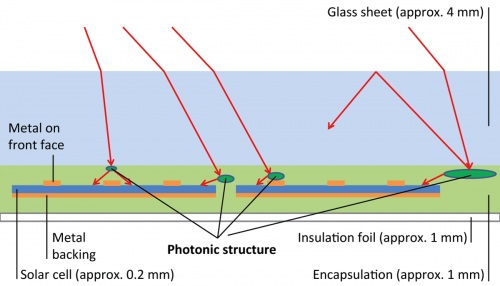As part of a research project with a timeframe of several years JOANNEUM RESEARCH Materials and NanoTecCenter Weiz are working on entirley new approaches to making PV modules more efficient. While intensive research into increasing the efficiency of solar cells is being conducted in many countries, little attention has so far been paid to the potential for improving the efficiency of the whole module, which is of the same order of magnitude.
More than 80% of the PV modules currently being produced employ solar cells fabricated from silicon wafers. These cells are fully metal-backed, with a metal lattice on the front face. A significant proportion of the sunlight reaching the module face is wasted, since around 7 to 9 % of the front of the cell is in the shadow of electrodes, while roughly 10 to 15 % of the module area is not covered with cells (for production engineering reasons); so overall optical losses add up to around 20 % of the light impinging on the module.
With the aid of photonic structures specially developed to deal with this the research team now intend to utilize the sunlight impinging on the inactive module area. These structures, implanted in the PV module, are designed to direct light specifically onto the active area of the solar cells, so as to make the module more efficient overall. The goal is to halve the optical losses, and thus to boost module performance by 10 % and module efficiency by 1.5 %.
On the way to realizing this aim, optical simulation is used to evaluate how diffractive and refractive optical structures can direct light precisely in a module; tailor-made structures can then be developed. To fabricate these structures and integrate them in test modules, a variety of low-cost methods are to be employed, such as laser processing or ink-jet printing.
